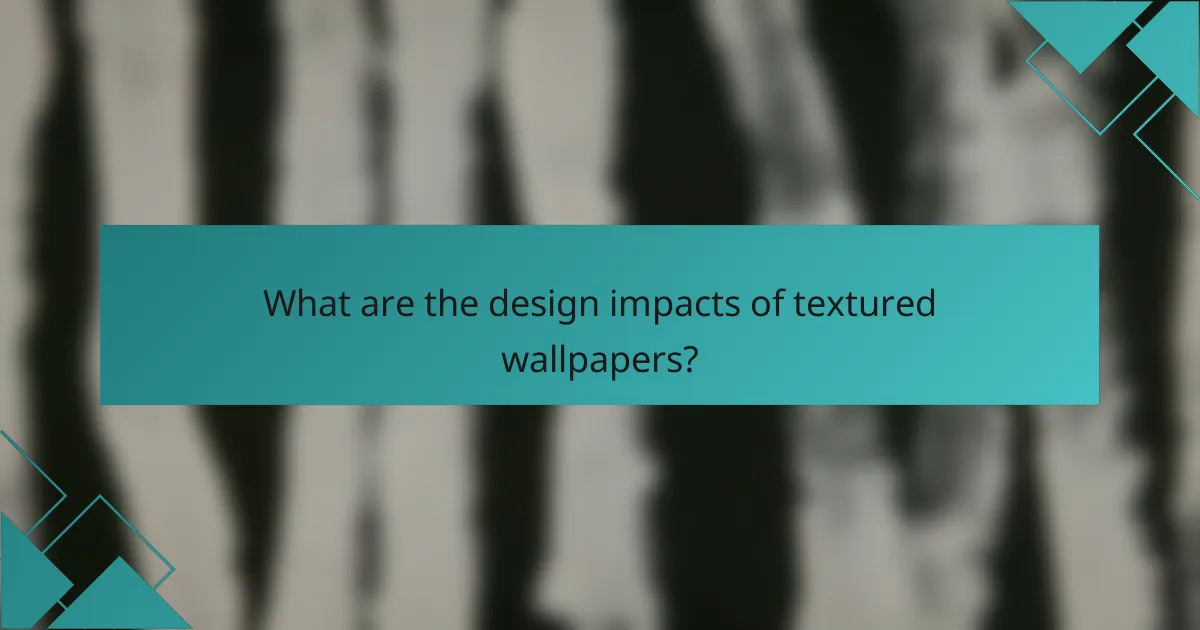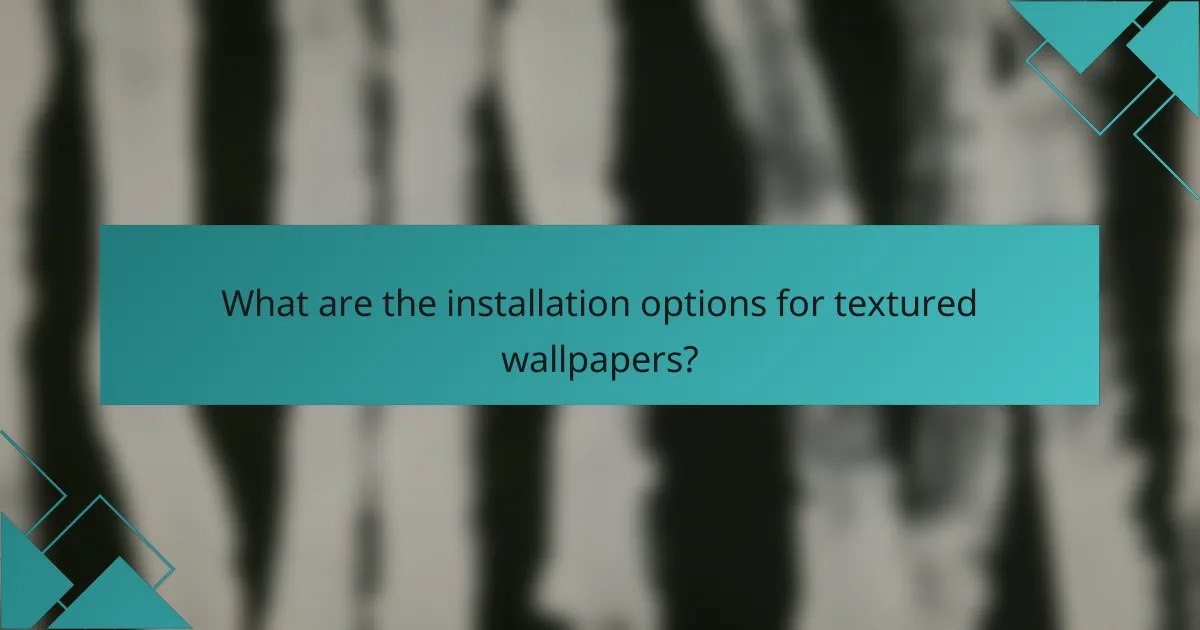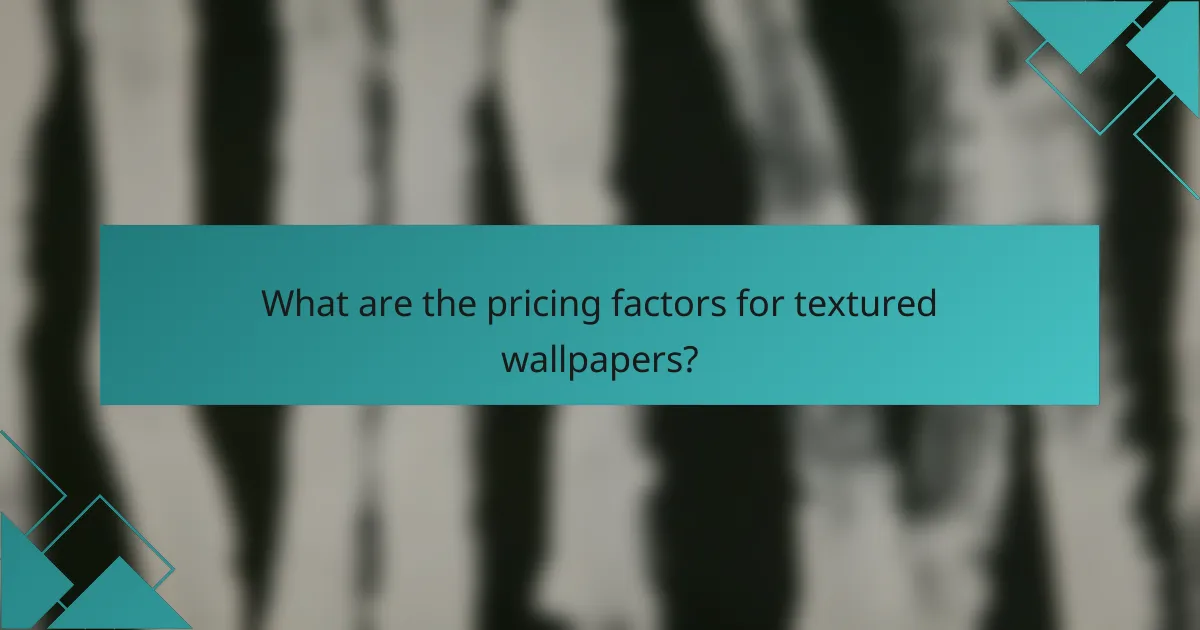Textured wallpapers serve as a powerful tool for enhancing the aesthetics of any space, adding depth and visual interest that can transform a room’s ambiance. With a variety of materials available, such as vinyl and grasscloth, these wallpapers not only elevate design but also influence acoustics and mood, making them a versatile choice for interior decoration.

How do textured wallpapers enhance aesthetics in homes?
Textured wallpapers enhance aesthetics in homes by adding visual interest and depth to walls, transforming the overall ambiance of a space. They create a unique backdrop that can elevate the design and style of any room.
Visual depth and dimension
Textured wallpapers introduce a three-dimensional quality to flat surfaces, making rooms feel more dynamic and inviting. By choosing wallpapers with raised patterns or embossed designs, homeowners can create focal points that draw the eye and add character to otherwise plain walls.
Consider using textured wallpapers in smaller spaces to create an illusion of depth. For example, a subtle linen texture can make a narrow hallway feel wider and more open.
Unique patterns and styles
Textured wallpapers come in a variety of patterns and styles, allowing for personalization and creativity in home design. From rustic wood grains to modern geometric shapes, these options cater to diverse tastes and can complement different interior themes.
When selecting a pattern, consider the existing decor. A bold, textured wallpaper can serve as a statement piece, while a more subdued design can enhance the overall aesthetic without overwhelming the space.
Color variation impact
The color of textured wallpapers plays a crucial role in setting the mood of a room. Lighter colors can make spaces feel airy and open, while darker shades can create a cozy and intimate atmosphere. Textures can also influence how colors are perceived, adding depth and richness.
For a balanced look, combine textured wallpapers with solid-colored furnishings. This contrast can highlight the wallpaper’s unique qualities while maintaining a cohesive design.
Light reflection and absorption
Textured wallpapers can affect how light interacts with walls, influencing the overall brightness of a room. Glossy textures reflect more light, making spaces feel larger and more vibrant, while matte finishes absorb light, creating a softer, more subdued environment.
When choosing a wallpaper, consider the natural light available in the room. In well-lit areas, a matte textured wallpaper can add warmth, while a glossy option might be better suited for darker spaces to enhance brightness.

What are the design impacts of textured wallpapers?
Textured wallpapers significantly enhance design by adding depth and visual interest to spaces. They can transform a room’s aesthetic, influence acoustics, and affect the overall mood, making them a versatile choice for interior decoration.
Creating focal points
Textured wallpapers can effectively create focal points in a room by drawing attention to specific areas. For instance, a bold, textured feature wall can serve as the centerpiece of a living room, guiding the eye and enhancing the overall design. Consider using contrasting textures or colors to further emphasize these focal points.
When selecting a textured wallpaper, think about the room’s layout and how the texture will interact with other design elements. A well-placed textured wall can enhance architectural features or artwork, making them stand out even more.
Improving room acoustics
Textured wallpapers can improve room acoustics by absorbing sound, reducing echo, and enhancing overall sound quality. This is particularly beneficial in spaces like home theaters, music rooms, or offices where clear audio is essential. The thickness and material of the wallpaper can influence its sound-absorbing properties.
For optimal acoustic benefits, consider wallpapers made from materials specifically designed for sound absorption, such as fabric or foam-backed options. These can help create a more comfortable auditory environment, especially in larger or more open spaces.
Influencing mood and ambiance
The choice of textured wallpaper can significantly influence the mood and ambiance of a room. Soft, warm textures can create a cozy and inviting atmosphere, while sleek, modern textures may evoke a sense of sophistication and calm. Color also plays a crucial role in this dynamic.
When selecting wallpaper, consider the psychological effects of colors and textures. For example, light, airy textures in soft blues or greens can promote relaxation, while bold, dark textures can add drama and energy. Aim for a balance that aligns with the desired mood of the space.

Which textured wallpaper materials are popular in the UK?
In the UK, popular textured wallpaper materials include vinyl, fabric-based options, and natural materials like grasscloth. Each type offers unique aesthetic qualities and practical considerations for interior design.
Vinyl textured wallpapers
Vinyl textured wallpapers are favored for their durability and ease of maintenance. They are water-resistant, making them suitable for high-humidity areas like kitchens and bathrooms.
When choosing vinyl wallpapers, consider the texture options available, such as embossed or printed designs. These can add depth and character to a room while being relatively easy to clean.
Fabric-based wallpapers
Fabric-based wallpapers, often made from materials like linen or silk, provide a luxurious feel and rich texture. They can enhance the warmth and elegance of a space but may require more care compared to vinyl.
These wallpapers are best suited for low-traffic areas, such as bedrooms or dining rooms, where they can be appreciated without the wear and tear of everyday use. Regular dusting and occasional professional cleaning are recommended to maintain their appearance.
Natural materials like grasscloth
Natural materials, such as grasscloth, offer a unique, organic texture that can bring a sense of nature indoors. Grasscloth is made from woven grasses and is often used to create a calming atmosphere in living spaces.
While beautiful, grasscloth requires careful installation and maintenance, as it is not washable and can be sensitive to moisture. It’s ideal for accent walls or areas with minimal exposure to dirt and humidity, enhancing the overall design without overwhelming the space.

How to choose the right textured wallpaper for your space?
Choosing the right textured wallpaper involves considering the room’s size, lighting, and existing decor. A well-selected wallpaper can enhance the aesthetic appeal and create a cohesive design in your space.
Assessing room size and lighting
The size of the room and its lighting conditions significantly influence wallpaper selection. In smaller rooms, lighter textures and colors can create an illusion of space, while larger rooms can accommodate bolder patterns and darker shades.
Natural and artificial lighting also play a crucial role. Test wallpaper samples in different lighting to see how textures and colors change throughout the day. This will help ensure the wallpaper complements the room’s ambiance.
Matching wallpaper with existing decor
When selecting textured wallpaper, consider the existing decor elements such as furniture, flooring, and color schemes. Aim for a harmonious balance; for instance, if your furniture is sleek and modern, a subtle textured wallpaper can add depth without clashing.
Use a color wheel to find complementary colors that enhance your decor. If your space features bold colors, opt for a more neutral wallpaper to avoid overwhelming the room.
Considering maintenance and durability
Maintenance and durability are essential factors when choosing textured wallpaper. Some materials, like vinyl, are easier to clean and more resistant to moisture, making them suitable for high-traffic areas or rooms with high humidity, such as kitchens and bathrooms.
Evaluate the wallpaper’s durability based on its intended use. For example, if you have children or pets, consider more robust options that can withstand wear and tear. Always check the manufacturer’s recommendations for cleaning and care to ensure longevity.

What are the installation options for textured wallpapers?
Textured wallpapers can be installed using various methods, primarily DIY techniques or by hiring professional installers. Each option has its own advantages, depending on your skill level, budget, and desired finish.
DIY installation techniques
DIY installation of textured wallpapers can be a rewarding project for those with a bit of experience in home improvement. Common methods include paste-the-wall, peel-and-stick, and traditional paste-and-hang techniques. Ensure you follow the manufacturer’s instructions for the best results.
When opting for DIY, consider starting with smaller areas to build confidence. Tools such as a smoothing tool, utility knife, and level will be essential for a clean finish.
Hiring professional installers
Hiring professional installers can save time and ensure a high-quality finish, especially for intricate designs or large spaces. Professionals typically have the experience and tools necessary to handle challenging installations, including aligning patterns and managing seams effectively.
Costs for professional installation can vary widely, often ranging from $1 to $5 per square foot, depending on the complexity and the installer’s expertise. Always request quotes from multiple professionals to find the best fit for your budget.
Preparation and tools needed
Proper preparation is key to a successful textured wallpaper installation. Start by ensuring the walls are clean, dry, and smooth; any imperfections should be patched and sanded down. Remove any existing wallpaper or paint that may interfere with adhesion.
Essential tools for installation include a tape measure, level, smoothing tool, utility knife, and a wallpaper brush. Having these tools on hand will streamline the process and help achieve a professional-looking result.

What are the pricing factors for textured wallpapers?
The pricing of textured wallpapers is influenced by several key factors, including material quality, brand reputation, and design complexity. Understanding these elements can help you make informed decisions when selecting and budgeting for your wallpaper project.
Material quality and type
The quality and type of material used in textured wallpapers significantly affect their price. Common materials include vinyl, fabric, and paper, with vinyl often being more durable and easier to clean, thus commanding a higher price. Higher-end options, such as silk or custom textiles, can range from moderate to premium pricing.
When considering material, think about the intended use of the wallpaper. For high-traffic areas, investing in more durable materials may save costs in the long run due to reduced wear and tear. Always check for certifications or ratings that indicate the wallpaper’s durability and ease of maintenance.
Brand reputation and design complexity
Brand reputation plays a crucial role in the pricing of textured wallpapers. Established brands with a history of quality and innovative designs often charge more due to their perceived value. Conversely, lesser-known brands may offer more affordable options, but the quality may vary.
Design complexity also impacts pricing. Simple patterns or textures typically cost less than intricate designs that require more detailed manufacturing processes. Custom designs or wallpapers that incorporate unique textures or finishes can significantly increase the price. When selecting a wallpaper, weigh the aesthetic appeal against your budget to find the right balance.
